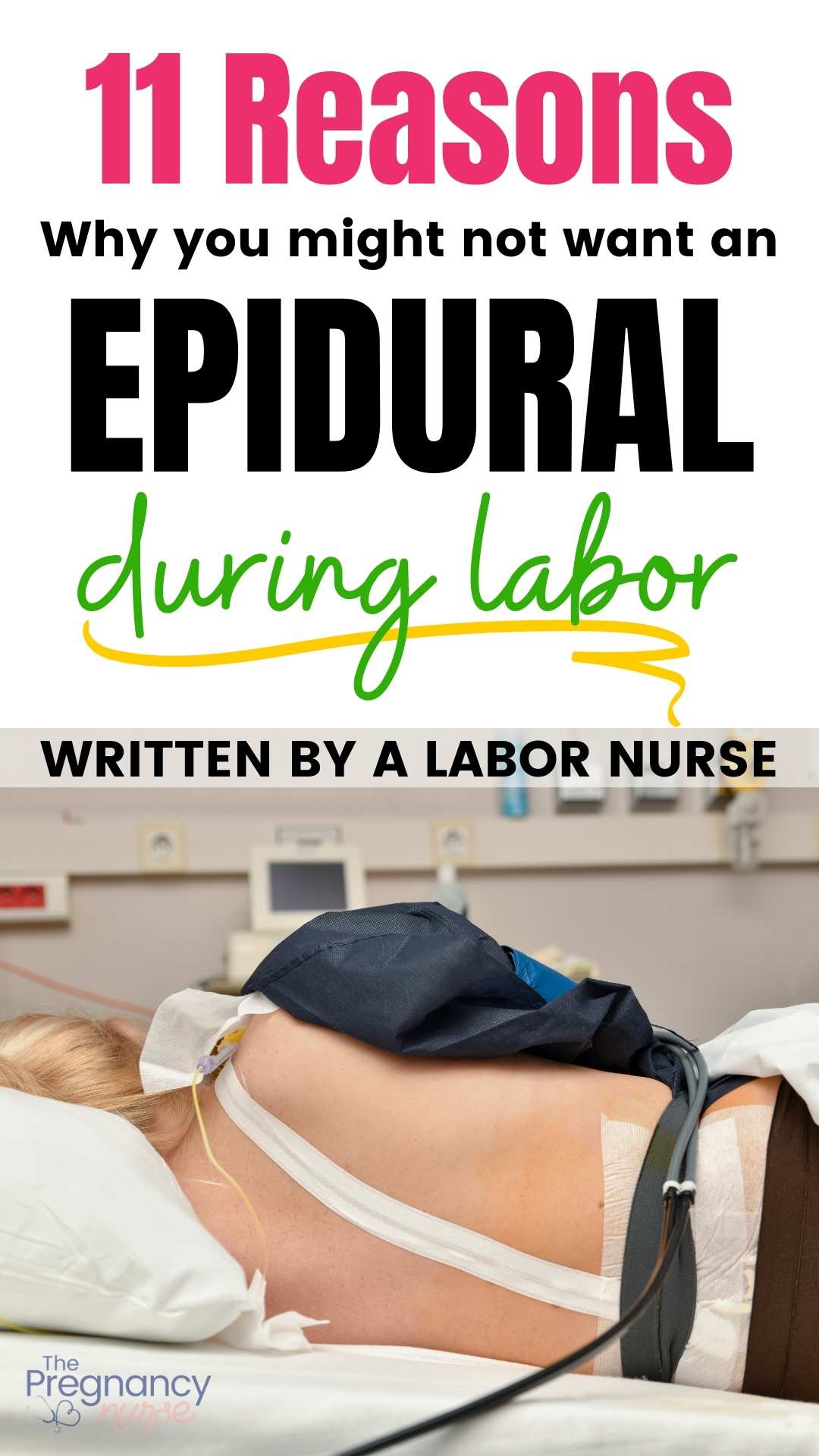👋 I’m so glad YOU are here. Are you looking to also get your partner prepared? This is for BOTH of you. Couples just love it and I know you want to both feel prepared!
Did you know that only about 60 percent of women in the United States actually receive epidurals for pain relief during labor? Despite what many people believe, epidurals are not always the best option for pregnant women. In this blog post, we will discuss some of the risks and benefits associated with getting an epidural during labor. We hope that after reading this post, you will be better informed about whether or not an epidural is right for you. Stay tuned!
But first, how do I know all of this? Hi — I’m Hilary — The Pregnancy Nurse 👩⚕️. I have been a nurse since 1997 and I have 20 years of OB nursing experience, I am also the curly head behind Pulling Curls and The Online Prenatal Class for Couples. 🩺 I have helped thousands of pregnant patients get an epidural (and got 3 of my own as well), so I am a good one to tell you what types of risks you might have.
And don’t worry — I did write a post on the reasons TO get an epidural that you should check out. 🙂
This is part of my Complete Guide to Epidurals — so if you have more questions don’t miss that!
And, before we get going — let me discuss your pain management options with you:
Epidurals do have side effects & complications
It is easy to think a procedure that is done so frequently isn’t a problem. And frankly, most often it isn’t. but there are side effects.
The most common side effect of an epidural is a drop in blood pressure. This can cause you to feel faint or even dizzy. In some cases, it can also lead to nausea and vomiting.
Some women also experience itching after the epidural. We can give you medication to help with this, it can be annoying. However, I find that the itching most-often dissipates after the first hour.
Epidurals can also cause more serious complications, such as:
Severe headache – This can occur if the epidural needle punctures your dura mater, which is the outermost layer of your meninges (the three membranes that surround your brain and spinal cord). It can let a bit of spinal fluid leak out — causing the headache. This can be managed with another procedure called a blood patch though.
Fever – A small number of women develop a fever after receiving an epidural. I find that it resolves after labor (may have something to do with the cold fluid running next to your spinal column which tells it to increase your temperature).
**When you get your epidural they will do an informed consent with you, and should go over all these things. These next ones are VERY rare — but I thought you might want a heads-up about them ahead of time. Please remember that birth control, driving a car, and many other simple things we do daily can cause many of these as well.
Nerve damage – In rare cases, the epidural needle can damage the nerves in your spine. This can cause permanent numbness, tingling, or weakness in your legs. There is always talk about if epidurals cause back pain.
Allergic reaction – Some women are allergic to the medication used in epidurals. This can cause a rash, hives, or even difficulty breathing. {this is VERY different than the itching that is more frequently experienced that I talked about above}
Spinal cord injury – In very rare cases, an epidural can cause a spinal cord injury. This can lead to paralysis of your legs and lower body.
Death – Although it is extremely rare, it is possible to die from an epidural. This is usually due to a severe complication, such as a spinal cord injury or a brain hemorrhage.
As a note, after 20 years of the bedside I have only heard of some VERY mild nerve damage (that resolved) and none of these others. They are EXTREMELY infrequent.
As you can see, there are some risks associated with getting an epidural during labor. However, it is important to remember that most women who receive an epidural do not experience any complications. If you are considering an epidural, be sure to discuss the risks and benefits with your doctor.
I really hope this first one hasn’t scared you off. It truly is NOT a reason to not get it if you really want it. It is important to get educated about what COULD happen, but more importantly to know more about what most often happens and what the majority of people should expect. Which is what a good prenatal class is for.
Epidurals may delay labor
One of the potential drawbacks of getting an epidural is that it may delay the progression of labor. In fact, one study found that women who received an epidural were more likely to require Pitocin (a medication used to induce or speed up labor) than women who did not receive an epidural. They were also more likely to have a forceps or vacuum delivery.
Additionally, some research suggests that epidurals may increase the risk of cesarean delivery. However, it is important to keep in mind that this is only a potential risk. The vast majority of women who receive an epidural do not end up having a cesarean delivery.
HOWEVER, let’s remember that women who are having more complicated deliveries in general often get an epidural. So, the studies aren’t quite comparing exactly the same thing.
Personally, I find that labor sometimes slows down due to the fluids we give patients before the epidural. It dilutes it so it isn’t as potent in their system. As those fluids are removed labor continues normally.
Epidural patients get a lot of fluids
As I just said — before you get an epidural we try to give you a liter of fluid. This is to prevent any drops in blood pressure due to the numbing/pain relief.
However, those extra fluids can cause swelling, and increased urination after delivery.
Studies have also shown that some of those fluids get to the baby and they may lose weight more quickly after delivery because it was just the excess fluid. Sometimes pediatricians encourage moms to supplement with formula if baby isn’t back to birth weight by 2 weeks. However, if some of that birth weight was that excess fluids it wouldn’t be as disconcerting. So, it is something to be aware of.
Keep in mind that the epidural itself is NOT preventing breastfeeding, it’s just harder to tell how baby is actually gaining weight…. Many people like to say that epidurals prevent breastfeeding — that isn’t true at all.
Interested in ALL the facts like this talk about fluids. Join me in The Online Prenatal Class for Couples to get prepared for your birth!
Epidurals are numbing
Another common side effect is a loss of feeling in your legs. This is because the medication used in an epidural numbs your nerves.
You should plan for your body to be about 80% numb from about your bra line to your knees.
Many patients have a real issue with that numb feeling and aren’t able to tolerate it very well (or didn’t know it would feel like that). Just something to be aware of.
{of course, most people in labor appreciate the numbing} I have a podcast on what epidurals feel like that you might enjoy.
Epidurals may make it harder to push
Another potential downside of getting an epidural is that it may make it more difficult for you to push when it is time to deliver your baby. This is because the medication used in an epidural can cause your muscles to relax. In one study, women who received an epidural were more likely to need assistance with delivery (such as forceps or vacuum) than women who did not receive an epidural (keeping in mind that women with more complicated deliveries in general often get an epidural).
However, it is important to keep in mind that this is only a potential risk. Most women who receive an epidural are able to deliver their baby without any assistance.
Personally, I find that most women are able to find their “zone” after a few pushes (even if the first few feel weird because of the numbing).
Pro Tip: You can also ask to have the epidural turned down if you aren’t feeling enough to adequately pushed. It isn’t all or nothing!
And yes — learning about HOW to push is something you can do ahead of time. You can get prepared in this class to push like a pro!
Epidurals Require a Sharp Needle
One of the most common complaints about epidurals is the pain (and fear) associated with getting the needle inserted into your back. Although this pain is usually only temporary, it can be quite uncomfortable. If you are worried about the pain of getting an epidural, be sure to discuss your concerns with your doctor or nurse ahead of time.
Pro Tip: Most providers numb the area before inserting the needle. So, you feel the “bee sting” of the numbing and then just some pressure when they insert the needle.
Want to know more about the epidural placement — check out my video all about it:
Epidurals Take time to Work
Another potential downside of epidurals is that they can take up to 20 minutes to work. This means that you may still feel some pain during this time. Which means if your baby is coming out in those 20 minutes it may not be effective as you’d like.
In some facilities it can take up to an hour before you’re feeling comfortable (sometimes you need to wait for the anesthesiologist, and then add the placement time and the medication working time).
If your providers are sure your baby is coming right away — I would focus on trying to remain calm with the pain vs trying to handle an epidural placement.
I do have a post on the best time to get an epidural that explains more about that, and I also have a post on when it’s too late to get an epidural.
You Need a Catheter with an Epidural
Another potential downside of getting an epidural is that you will need to have a catheter inserted in your bladder. You won’t be able to get up to pee (and using bedpan is REALLY difficult with an epidural). Also, most people aren’t able to relax their muscles to urinate as usual.
Although this is not a major concern for most women, some people are scared of the catheter — so I think it is worth mentioning.
Pro Tip: The catheter is most often placed after the epidural is working, meaning you are numb and don’t feel the procedure.
I have a whole post on foley catheters if you want more information on that.
You Can’t Move as Well with an Epidural
Another potential downside of getting an epidural is that it can make it difficult to move around. This is because the medication used in an epidural can cause your muscles to relax. As a result, you may need help from your nurse or partner to change positions. Additionally, you will likely be confined to your bed during labor. It does not, however, mean you have to give birth on your back.
Pro tip: I hear a LOT about :”walking epidurals” but have found that most facilities don’t do them, or if they do it’s just enough to sit by the bed. If it is something you are interested in, talk with your provider early.
Epidurals are Only Given in Hospital Settings
If you are planning on having a home birth or birth center birth, an epidural may not be an option for you. This is because epidurals can only be given in hospital settings. So, if you are set on having an epidural, you will need to make sure that you give birth in a hospital.
Epidurals are expensive!
An epidural can cost upwards of $1,000 (this price varies a LOT and is often hard to find out in advance). So, if you are hoping to avoid spending a lot of money on your birth, an epidural may not be the best option for you (most insurances do cover this — it’s really only an issue if you’re not using insurance).
What are the Alternatives to Epidurals?
If you are looking for pain relief during labor but are not interested in getting an epidural, there are a few other options available to you. I recently did a podcast pain management options in labor:
Your basic alternatives are:
1. Nitrous oxide — this is offered at some hospitals — so ask your provider if you are interested in this to make sure they have it at your delivery facility. It is similar to laughing gas that they provide at dental offices.
2. Pain medication — IV pain medication is a good option, but is only effective a few times. Not a good long-term option.
3. “Natural Pain Management” — be it breathing, hypno-birthing or something else. Many women find this method very effective.
And yes, I do have a whole chapter on natural pain management options in The Online Prenatal Class for Couples. We’ve got you covered!
Ok, I hope this prepared you for an epidural. I always tell my students & patients that there is no reason to make your mind up ahead of time. You can have something you’d like to “try” but when labor comes you may find yourself not needing the epidural or perhaps you’ll want one when the labor pains start.
Being flexible is one the most important things I teach in The Online Prenatal Class for Couples. That, and being informed of what usually happens so you feel more confident. Come join us — the class starts at just $35 dollars, it only takes a few hours and is taught by a highly experienced RN (Me).
Want to do a vibe check before diving into the whole thing with me? — check out my free labor pro tips. It’s your first step toward getting in the driver’s seat of your birth.









 Easy Tips on What to do if you Pulled a Stomach Muscle During Pregnancy: Third Trimester Problems
Easy Tips on What to do if you Pulled a Stomach Muscle During Pregnancy: Third Trimester Problems
